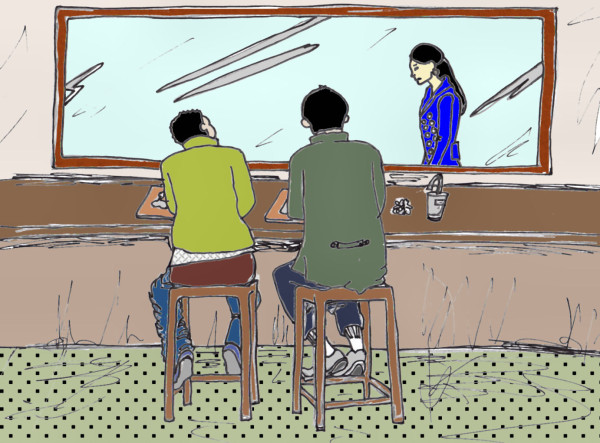
Let me start my first article on a lighter note–an anecdote from my freshman year of college, more than 10 years ago. I was at the In-N-Out across the street from the dorms sitting on a bar stool along with two Asian-Americans dormmates I had just met. We sat facing the window, with a clear panoramic view of the campus. It was orientation week at UC-Irvine, so school hadn’t yet started, but I was excited. Finally, after six years living in the Midwest, I was in California and, happily, already making friends.
A short Asian girl with an oversize backpack passed our view. “She definitely Chinese,” said the guy sitting next to me.
I looked at her, perplexed. Did they mean ethnically? After all, this was UCI, and though it was majority Asian, it was also 98% Californian. There were very few international students here. And how could they tell her nationality just by looking at her?
“That one, definitely Korean,” said the other guy, pointing at a tall guy in glasses. Was this some sort of game Californians played? Guess-the-ethnicity? Was it a skill?
“Filipino for sure!”
Across the street, I saw two Caucasians males walking toward the In-N-Out. I could play this game too.
“Over there, that guy is definitely German, and the other, Irish,” I said, barely able to not giggle. I turned to them, expecting laughter.
Instead, two faces stared at me with a mix of perplexion and pity, clearly saying – are you mentally troubled?
Hurt, and not sure how to respond, I quietly went back to my burger.
That was my culture shock, and despite traveling to Asia, Africa, and Europe in the subsequent years, nothing was ever as hard as that first move from Kansas City to California and being surrounded by, for the first time, other Asians. Or, at least, that’s what I thought.
Growing up in the Midwest, I’d always felt out of place, and, naturally, blamed it on where I was. It wasn’t lack of diversity per se — sure, my high school was mostly white, but within “white” were Irish-Catholics, Southern Baptists, German Protestants, and a large Jewish minority. My best friend, in fact, was Jewish and resoundly rejected being called “white.” Diversity exists everywhere, but only if we want to see it.
No, my dislike was more to do with the bubble my suburban high school was in, disconnected from not only urban Kansas City just up the freeway, but the world as a whole. We were, after all, more than a thousand miles from any border, as Americana as you could get. I knew that there was more out there, and hoped that in California, I would be more connected to it, and find others like me.
Yet, as my intro shows, my return to California was far from smooth. Ethnicity, which I’d tried to ignore my whole life, all of a sudden was in the forefront. My skin color mattered — so much so that people made judgments based on it (“So you must be studying Engineering?”), judgments I’d never been exposed to before, cloaked in so-called cosmopolitan cultural intelligence.
In the Midwest, no one would ever ask your ethnicity — it would be impolite. However students at UCI seemed to have no such qualms. So when my Asian-American roommate first asked me about my race, I answered as I always had.
“I’m Asian,” I said. There was a pause.
“You’re not Asian,” he responded curtly.
For a few seconds, I was too shocked to respond.
I’m Asian. You’re Indian,” he continued. In his mind, he was both Asian and Chinese. But I was just Indian. We also never became friends.
It got harder from there. On the second day of class, I walked through the student center, where everyone was eating lunch. I froze. Each table in the outdoor plaza was filled with a different ethnicity. Where did I fit into this scheme? As my roommate had showed me, I wasn’t “Asian” enough to hang out with the Chinese, Koreans, or Filipinos, and, conversely, not “Indian” enough for the Indian cliques either. Even the white students were unapprochable, an antagonistic minority, nothing like my mostly white friends in high school.
I was as out of place in California as I had been in Kansas, despite the dramatic increase in diversity. But, it was, as I would later see clearly, diversity in name only, and that the clique-ish behavior I saw was, I’d later learn, a natural reaction to far greater forces at play all across America.
As an antsy 19-year-old, I reacted as I always had. I left. The next year, I studied abroad in France, and would, with time, travel the world to expand my mind. Upon returning to California, at a new University, I formed my own clique with a bunch of diverse misfits, united in our differences, not, like the cliques at UCI, in our common skin color or parents’ birthplace. They challenged me to think and destroy preconceptions.
The prejudices I was exposed to as a freshmen have made me resoundedly anti-stereotype, and I pride myself on not only breaking barriers, but not judging others by appearance either. At the same time, my respect and pride in my own culture has grown – South Indian, Hindu, Buddhist, American, and yes, Asian.
It wasn’t an easy journey, and I still have a lot to learn. As a contributor to 8Asians, I hope to explore issues of identity from my own unique Asian-American perspective, all stemming from my reaction to moving to California back in 2001.
And just to be clear. I AM Asian.








